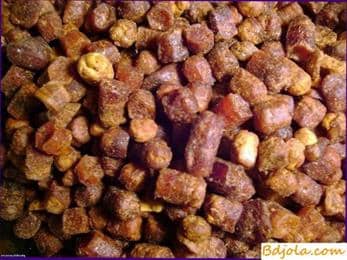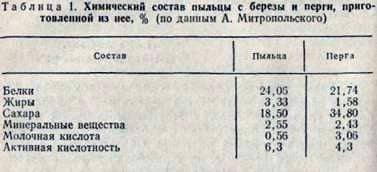
The bee sheds the update in the cell with the help of the spurs on the middle legs. Then the other bees flatten and compact the refresh. Gradually, the cell accumulates many layers of pollen collected by different bees from flowers of different plants. Dropping the updates takes only 15-20 seconds, but tampering the pollen in the cell requires a long work of many bees.
The bee brought in the beehive is folded into the cells on the top and side of the brood. In a beehive, the honeycomb with brood always contain more or less wide rings of cells with pergolas from the sides. When the brood is expanded, the bees select a pearl from the cells, create a rupture in the ring, which is then expanded, the uterus fills the released cells with eggs, and the bees create a new ring of larger diameter from the pie.
Bees never fill cells up to the top. Perga takes on average 57% of the cell volume (with fluctuations from 36 to 77%). This is because the bee must have a reliable support in the cell to spread and compact the update. If the cell is filled with a pearl to the top, then there will be no such points for support.
One cell contains, on the average, 140 mg of Perga (with fluctuations from 102 to 175 mg). One honeycomb, in which 3/4 of the cells (6000) on both sides are filled with perga, contains about 840 g of perga. A kilogram of perga will take about 7,000 cells.
The top layer of Perga prepared for long-term storage, the bees are impregnated with honey, as a result of which the surface of the Perga has a reflection. During the honey-collecting cell with such a bee, bees are very willingly added with honey and sealed. It turns out honey-pergovy honeycomb, in which the pepper is very well preserved.
In the cell, the dense renewal turns into a product called perga.
Perga contains more sugar than pollen, due to nectar and honey, which the bees mix with it. Perpe contains a lot of lactic acid, and its active acidity is increased (Table 1).

According to the chemical processes that occur in the cell with Perga, the cell can be compared with a miniature silo tower. It is known that silage is tightly compacted to stop the access of oxygen to the silous mass. The same is done by the bees, densely ramming the pollen in the cell. In the silo, due to the available sugars, lactic acid bacteria develop which, while producing lactic acid, preserve the food, preventing the development of putrefactive bacteria. A similar process occurs in the cell with Perga. The high temperature of the nest of bees favors the rapid development of bacteria and the accumulation of lactic acid.
Placing the perga along the edges of the brood allows the bee-wet nurse to quickly find the protein food needed for her, and also improves the thermal regime of the nest. All honeycomb cells on the sides of brood bees are filled with perga (covering cells).

Table 2 shows data showing the thermal qualities of identical honeycombs filled with honey and perga.
Honeycombs with perga have a much lower thermal conductivity and contribute to better preservation of heat in the brood nest.
Разметить трубу. Соевая мука для пчел.
Feeding base of beekeeping